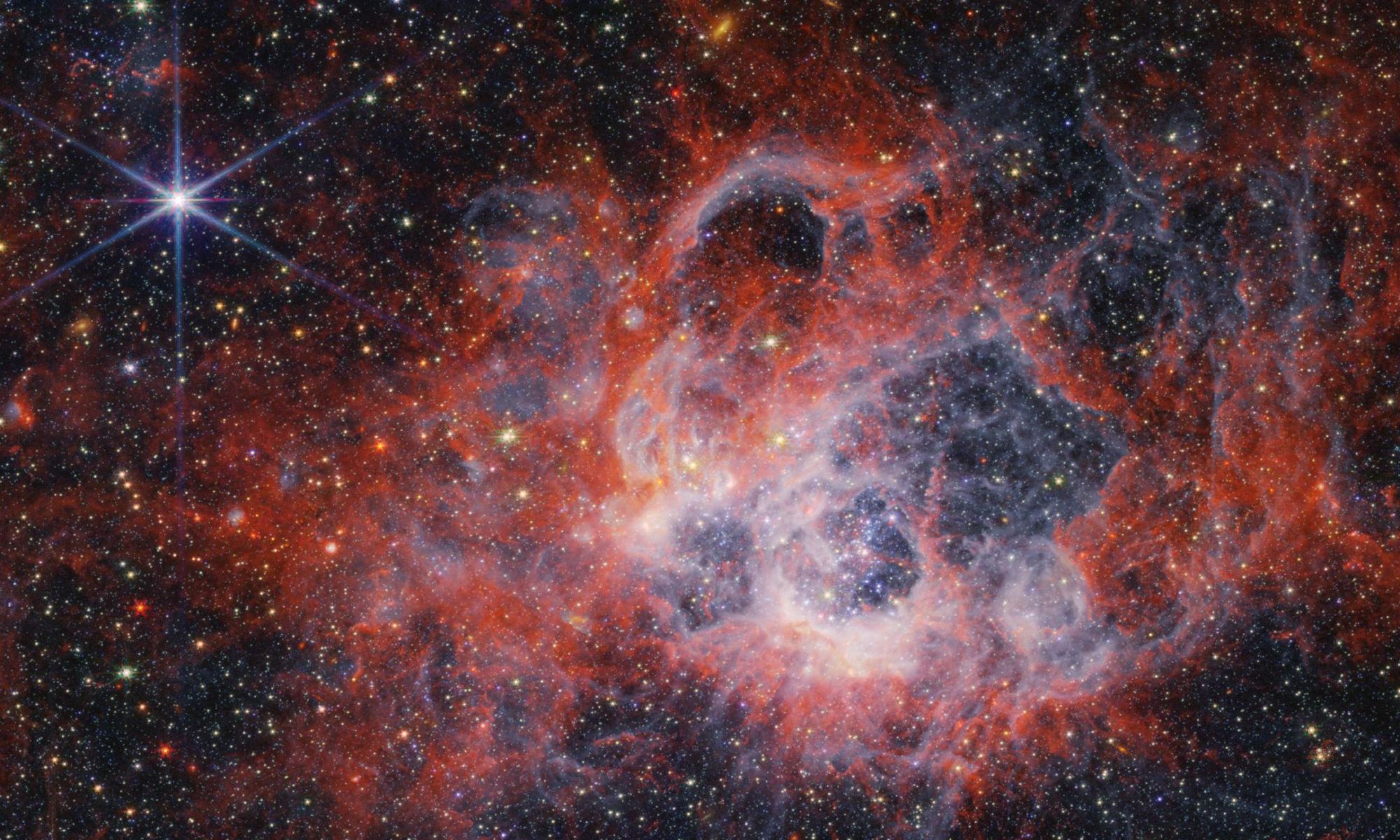Star birth is a messy and chaotic event. Some of the process remains well hidden behind clouds of gas and dust that make up star-forming regions. However, part of it happens in wavelengths of light we can detect, such as visible light and infrared. It’s an intricate process that the Webb telescope (JWST) can study in detail.
Recently this infrared-sensitive space observatory zeroed in on a portion of a star-forming region called NGC 604 in the Triangulum galaxy and returned a pair of amazing images. The telescope’s Near-infrared Camera (NIRCam) image shows gas bubbles, and tendrils and wisps of glowing material lit up by more than 200 hot, young massive stars. Some of those stars are probably at least 100 times the mass of the Sun. Finding so many of them in such a small area of space is a rare occurrence.
JWST’s mid-infrared instrument (MIRI) identified glowing clouds of gas and dust in NGC 604 and a collection of red supergiant stars in the surrounding galaxy region. They’re cool and ancient, and most are hundreds of times the diameter of the Sun.
JWST Reveals the Chemistry of a Star-forming Region
As cool as these images look, the chemistry they reveal is amazing. Orange-colored streaks in the NIRCam image indicate the presence of polycyclic hydrocarbons (PAHs). These carbon-based molecules play a big role in star- and planet-forming processes. Here on Earth they’re pretty commonly found in coal, oil, gasoline, and as a by-product of burning these substances. Obviously, coal, gasoline, and burning garbage don’t exist in outer space. However, pure PAHs do, and they’re a good tracer of star formation. So, it’s not a surprise to find them in this particular nebula.
Deep red regions in the nebula are pockets of molecular hydrogen. That’s the basic building block of stars. In other places, hot young stars have ionized hydrogen gas, which appears white in the image. The MIRI images also show the distribution of cool gas and dust throughout the nebula, and blue tendrils identify the presence of more PAHs.

Dynamics of Star Birth
The chaotic part of star birth comes as hot young stars are born. They directly affect the stellar nursery by emitting copious amounts of ultraviolet radiation into space. That ionizes (heats) the surrounding birth clouds and causes them to glow. The stellar newborns also blow hot stellar winds like gas bubbles out around them. That carves out caverns in the dusty birth cloud and creates those tendrils.
The creation of stars gobbles up immense amounts of gas and dust. The most massive stars, like the ones seen in these images, basically clear out the region. That also shuts down (or severely stunts) future star formation. Eventually, the process of stellar creation will play itself out here, leaving behind clusters of massive, hot young stars, along with smaller more sun-like stars and even a few brown dwarfs.
About the NGC 604 Star-forming Region
NGC 604 is a pretty typical star birth creche, similar to the Orion Nebula in our own Milky Way Galaxy. It’s fairly extensive—it measures about 1,300 light-years across (much larger than the Orion star-birth complex) and lies about 2.7 million light-years away from us. The cloud has been making baby stars for at least 3.5 million years. Compare that to the Orion Nebula, which is about 1,400 light-years away from us and has been cranking out stars for about 3 million years. Its brightest stars lie in the Trapezium at the heart of the nebula. Many of Orion’s stars are quite young—only about 300,000 years old. The nebula also has a collection of brown dwarfs, as well as protoplanetary disks that harbor newly forming protostars.

JWST isn’t the first space telescope to study this region of space. The Hubble Space Telescope has looked at it often, beginning in the 1990s, and the Chandra X-Ray Observatory has traced its superheated stars in X-ray wavelengths. Ground-based observatories such as the Atacama Large Millimeter Array (ALMA), and others have long studied this region to gather as much information as possible about the structure of this nursery and its stars.
The starbirth process can take anywhere from 10,000 to 100,000 years for the highest-mass stars to millions of years for less-massive ones. So, when we look at a star-birth region, we’re looking at a fairly short-lived phenomenon in the overall 13.7 billion-year-long history of the Universe. That’s why astronomers are interested in learning more about the process, particularly in other galaxies such as the Triangulum.
For More Information
Peering Into the Tendrils of NGC 604 with NASA’s Webb
The Formation of Stars

